Loading AI tools
Genus of plants From Wikipedia, the free encyclopedia
Lilium (/ˈlɪliəm/ LIL-ee-əm)[3] is a genus of herbaceous flowering plants growing from bulbs, all with large and often prominent flowers. Lilies are a group of flowering plants which are important in culture and literature in much of the world. Most species are native to the Northern Hemisphere and their range is temperate climates and extends into the subtropics. Many other plants have "lily" in their common names, but do not belong to the same genus and are therefore not true lilies. True lilies are known to be highly toxic to cats.[4]
| Lilium | |
|---|---|
 | |
| Lilium candidum | |
| Scientific classification | |
| Kingdom: | Plantae |
| Clade: | Tracheophytes |
| Clade: | Angiosperms |
| Clade: | Monocots |
| Order: | Liliales |
| Family: | Liliaceae |
| Subfamily: | Lilioideae |
| Tribe: | Lilieae |
| Genus: | Lilium L.[1] |
| Type species | |
| Lilium candidum | |
| Species | |
| Synonyms[1] | |
| |
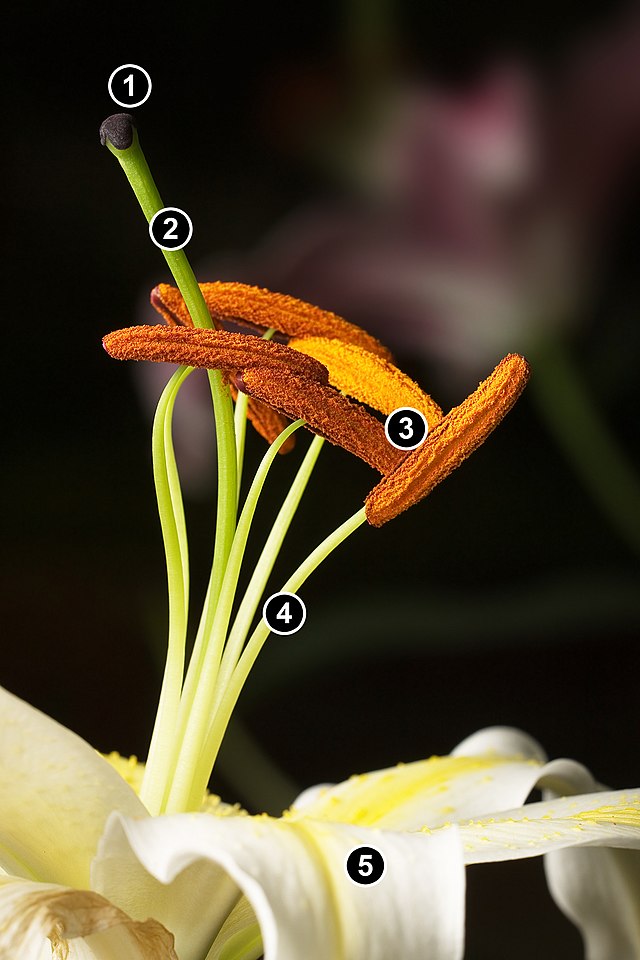
Lilies are tall perennials ranging in height from 1–6 ft (30–180 cm). They form naked or tunicless scaly underground bulbs which are their organs of perennation. In some North American species the base of the bulb develops into rhizomes, on which numerous small bulbs are found. Some species develop stolons.[5] Most bulbs are buried deep in the ground, but a few species form bulbs near the soil surface. Many species form stem-roots. With these, the bulb grows naturally at some depth in the soil, and each year the new stem puts out adventitious roots above the bulb as it emerges from the soil. These roots are in addition to the basal roots that develop at the base of the bulb, a number of species also produce contractile roots that move the bulbs deeper into the soil.[6]

The flowers are large, often fragrant, and come in a wide range of colors including whites, yellows, oranges, pinks, reds and purples. Markings include spots and brush strokes. The plants are late spring- or summer-flowering. Flowers are borne in racemes or umbels at the tip of the stem, with six tepals spreading or reflexed, to give flowers varying from funnel shape to a "Turk's cap". The tepals are free from each other, and bear a nectary at the base of each flower. The ovary is 'superior', borne above the point of attachment of the anthers. The fruit is a three-celled capsule.[7]

Seeds ripen in late summer. They exhibit varying and sometimes complex germination patterns, many adapted to cool temperate climates.
Most cool temperate species are deciduous and dormant in winter in their native environment. But a few species native to areas with hot summers and mild winters (Lilium candidum, Lilium catesbaei, Lilium longiflorum) lose their leaves and enter a short dormant period in summer or autumn, sprout from autumn to winter, forming dwarf stems bearing a basal rosette of leaves until, after they have received sufficient chilling, the stem begins to elongate in warming weather.

The basic chromosome number is twelve (n=12).[8]
In 2017, lilies ranked as the second most favorite flower among UK residents, highlighting their enduring popularity and cultural significance [9]
Taxonomical division in sections follows the classical division of Comber,[10] species acceptance follows the World Checklist of Selected Plant Families,[11] the taxonomy of section Pseudolirium is from the Flora of North America,[12] the taxonomy of Section Liriotypus is given in consideration of Resetnik et al. 2007,[13] the taxonomy of Chinese species (various sections) follows the Flora of China[14] and the taxonomy of Section Sinomartagon follows Nishikawa et al.[15] as does the taxonomy of Section Archelirion.[16]
The Sinomartagon are divided in 3 paraphyletic groups, while the Leucolirion are divided in 2 paraphyletic groups.[17]
There are seven sections:
There are 119 species counted in this genus.[18] For a full list of accepted species with their native ranges, see List of Lilium species.
| Picture | Section | Sub Section | Botanical name | common name |
|---|---|---|---|---|
 | Martagon | Lilium distichum | ||
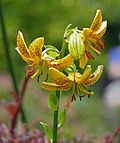 | Martagon | Lilium hansonii | ||
 | Martagon | Lilium martagon | Martagon or Turk's cap lily | |
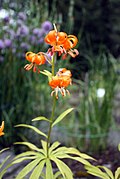 | Martagon | Lilium medeoloides | ||
 | Martagon | Lilium tsingtauense | ||
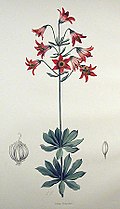 | Pseudolirium | 2a | Lilium bolanderi | Bolander's Lily |
 | Pseudolirium | 2a | Lilium puberulum | |
 | Pseudolirium | 2a | Lilium kelloggii | |
 | Pseudolirium | 2a | Lilium rubescens | |
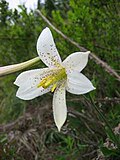 | Pseudolirium | 2a | Lilium washingtonianum | Washington Lily, Shasta Lily, or Mt. Hood Lily |
 | Pseudolirium | 2b | Lilium kelleyanum | |
 | Pseudolirium | 2b | Lilium maritimum | |
 | Pseudolirium | 2b | Lilium occidentale | |
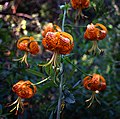 | Pseudolirium | 2b | Lilium pardalinum | Panther or Leopard lily |
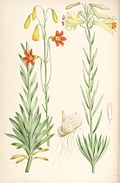 | Pseudolirium | 2b | Lilium parryi | |
 | Pseudolirium | 2b | Lilium parvum | Sierra tiger lily or Alpine lily |
 | Pseudolirium | 2c | Lilium canadense | Canada Lily or Meadow Lily |
 | Pseudolirium | 2c | Lilium grayi | |
 | Pseudolirium | 2c | Lilium iridollae | |
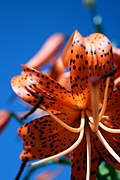 | Pseudolirium | 2c | Lilium michiganense | Michigan Lily |
 | Pseudolirium | 2c | Lilium michauxii | Carolina Lily |
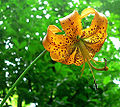 | Pseudolirium | 2c | Lilium superbum | Swamp lily or American tiger lily |
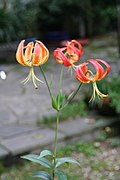 | Pseudolirium | 2c | Lilium pyrophilum | Sandhills Lily[19] |
 | Pseudolirium | 2d | Lilium catesbaei | |
 | Pseudolirium | 2d | Lilium philadelphicum | Wood lily, Philadelphia lily or prairie lily |
 | Liriotypus | 3a | Lilium candidum | Madonna lily |
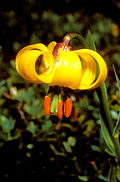 | Liriotypus | 3b | Lilium albanicum | |
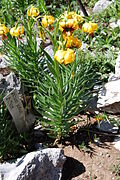 | Liriotypus | 3b | Lilium bosniacum (Lilium carniolicum var. bosniacum) | |
 | Liriotypus | 3b | Lilium chalcedonicum | |
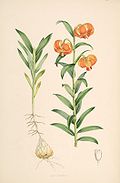 | Liriotypus | 3b | Lilium carniolicum | |
 | Liriotypus | 3b | Lilium ciliatum | |
| Liriotypus | 3b | Lilium heldreichii | ||
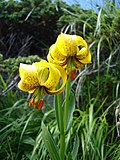 | Liriotypus | 3b | Lilium jankae | |
 | Liriotypus | 3b | Lilium pomponium | Turban lily |
 | Liriotypus | 3b | Lilium ponticum | |
 | Liriotypus | 3b | Lilium pyrenaicum | |
 | Liriotypus | 3c | Lilium akkusianum | |
 | Liriotypus | 3c | Lilium kesselringianum | |
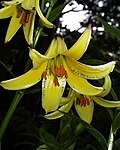 | Liriotypus | 3c | Lilium monadelphum | |
 | Liriotypus | 3c | Lilium rhodopeum | |
 | Liriotypus | 3c | Lilium szovitsianum | Polish Lily |
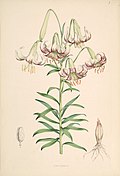 | Liriotypus | 3c | Lilium polyphyllum | |
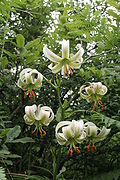 | Liriotypus | 3c | Lilium ledebourii | |
 | Liriotypus | 3d | Lilium bulbiferum | Orange Lily or Fire Lily |
 | Archelirion | 4a | Lilium speciosum | Japanese lily |
 | Archelirion | 4b | Lilium auratum | Golden rayed lily of Japan, or Goldband lily |
 | Archelirion | 4c | Lilium alexandrae | |
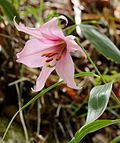 | Archelirion | 4c | Lilium japonicum | |
 | Archelirion | 4c | Lilium nobilissimum | |
 | Archelirion | 4d | Lilium brownii | |
 | Archelirion | 4d | Lilium rubellum | |
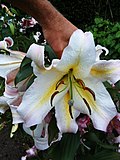 | Archelirion | 4d | Lilium platyphyllum | |
 | Sinomartagon | 5a | Lilium davidii | |
 | Sinomartagon | 5a | Lilium duchartrei | |
 | Sinomartagon | 5a | Lilium henryi | Tiger Lily or Henry's lily |
 | Sinomartagon | 5a | Lilium lancifolium | Tiger Lily (often known as L. tigrinum) |
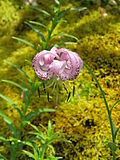 | Sinomartagon | 5a | Lilium lankongense | |
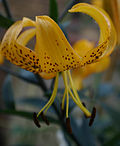 | Sinomartagon | 5a | Lilium leichtlinii | |
 | Sinomartagon | 5a | Lilium papilliferum | |
 | Sinomartagon | 5a | Lilium rosthornii | |
 | Sinomartagon | 5b | Lilium amabile | |
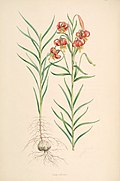 | Sinomartagon | 5b | Lilium callosum | |
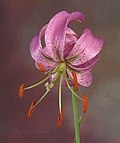 | Sinomartagon | 5b | Lilium cernuum | |
 | Sinomartagon | 5b | Lilium concolor | Morning Star Lily |
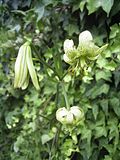 | Sinomartagon | 5b | Lilium fargesii | |
 | Sinomartagon | 5b | Lilium pumilum | Coral Lily, Low Lily, or Siberian Lily |
| Sinomartagon | 5b | Lilium xanthellum | ||
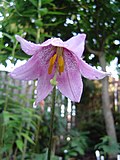 | Sinomartagon | 5c | Lilium amoenum | |
| Sinomartagon | 5c | Lilium arboricola | ||
 | Sinomartagon | 5c | Lilium bakerianum | |
 | Sinomartagon | 5c | Lilium euxanthum | |
| Sinomartagon | 5c | Lilium henrici | ||
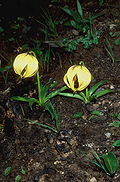 | Sinomartagon | 5c | Lilium lophophorum | |
 | Sinomartagon | 5c | Lilium mackliniae | Siroi Lily |
 | Sinomartagon | 5c | Lilium majoense | |
 | Sinomartagon | 5c | Lilium nanum | |
 | Sinomartagon | 5c | Lilium nepalense | |
 | Sinomartagon | 5c | Lilium oxypetalum | |
| Sinomartagon | 5c | Lilium paradoxum | ||
 | Sinomartagon | 5c | Lilium poilanei | |
 | Sinomartagon | 5c | Lilium primulinum | |
| Sinomartagon | 5c | Lilium sempervivoideum | ||
| Sinomartagon | 5c | Lilium sherriffiae | ||
 | Sinomartagon | 5c | Lilium souliei | |
| Sinomartagon | 5c | Lilium stewartianum | ||
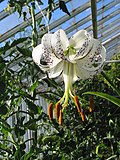 | Sinomartagon | 5c | Lilium taliense | |
 | Sinomartagon | 5c | Lilium wardii | |
| Sinomartagon | 5? | Lilium brevistylum | ||
 | Sinomartagon | 5? | Lilium lijiangense | |
| Sinomartagon | 5? | Lilium anhuiense | ||
| Sinomartagon | 5? | Lilium eupetes | ||
 | Sinomartagon | 5? | Lilium habaense | |
| Sinomartagon | 5? | Lilium huidongense | ||
| Sinomartagon | 5? | Lilium jinfushanense | ||
| Sinomartagon | 5? | Lilium matangense | ||
| Sinomartagon | 5? | Lilium medogense | ||
| Sinomartagon | 5? | Lilium pinifolium | ||
| Sinomartagon | 5? | Lilium pyi | ||
| Sinomartagon | 5? | Lilium saccatum | ||
| Sinomartagon | 5? | Lilium tianschanicum | ||
| Sinomartagon | 5? | Lilium floridum | ||
 | Leucolirion | 6a | Lilium leucanthum | |
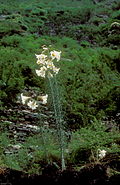 | Leucolirion | 6a | Lilium regale | |
 | Leucolirion | 6a | Lilium sargentiae | |
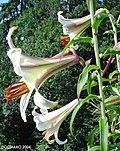 | Leucolirion | 6a | Lilium sulphureum | |
 | Leucolirion | 6a | Lilium wenshanense | |
| Leucolirion | 6b | Lilium anhuiense | ||
 | Leucolirion | 6b | Lilium formosanum | |
 | Leucolirion | 6b | Lilium longiflorum | Easter Lily |
| Leucolirion | 6b | Lilium neilgherrense | ||
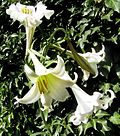 | Leucolirion | 6b | Lilium philippinense | Benguet lily[20][21] |
 | Leucolirion | 6b | Lilium wallichianum | |
| Leucolirion | 6b | Lilium zairii | ||
 | Leucolirion | 6b | Lilium puerense | |
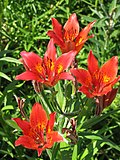 | Daurolirion | Lilium dauricum | ||
 | Daurolirion | Lilium maculatum | ||
 | Daurolirion | Lilium pensylvanicum | ||
| Lilium eupetes | ||||
 | Lilium armenum | |||
 | Lilium bosniacum | |||
 | Lilium columbianum | |||
 | Lilium debile | |||
 | Lilium humboldtii | |||
| Lilium rockii |
Some species formerly included within this genus have now been placed in other genera. These genera include Cardiocrinum, Notholirion, and Fritillaria.[22][23][24] Four other genuses, Lirium, Martagon, Martagon and Nomocharis are considered to synonyms by most sources.[18]
The botanic name Lilium is the Latin form and is a Linnaean name. The Latin name is derived from the Greek word λείριον leírion, generally assumed to refer to true, white lilies as exemplified by the Madonna lily.[25][26][27] The word was borrowed from Coptic (dial. Fayyumic) hleri, from standard hreri, from Demotic hrry, from Egyptian hrṛt "flower".[28] Meillet maintains that both the Egyptian and the Greek word are possible loans from an extinct, substratum language of the Eastern Mediterranean.[citation needed] Ancient Greek: κρῖνον, krīnon, was used by the Greeks, albeit for lilies of any color.[29]
The term "lily" has in the past been applied to numerous flowering plants, often with only superficial resemblance to the true lily, including water lily, fire lily, lily of the Nile, calla lily, trout lily, kaffir lily, cobra lily, lily of the valley, daylily, ginger lily, Amazon lily, leek lily, Peruvian lily, and others. All English translations of the Bible render the Hebrew shūshan, shōshan, shōshannā as "lily", but the "lily among the thorns" of Song of Solomon, for instance, may be the honeysuckle.[30]

The range of lilies in the Old World extends across much of Europe, across most of Asia to Japan, south to India, and east to Indochina and the Philippines. In the New World they extend from southern Canada through much of the United States. They are commonly adapted to either woodland habitats, often montane, or sometimes to grassland habitats. A few can survive in marshland and epiphytes are known in tropical southeast Asia. In general they prefer moderately acidic or lime-free soils.
Lilies are used as food plants by the larvae of some Lepidoptera species including the Dun-bar.
The proliferation of deer (e.g. Odocoileus virginianus) in North America, mainly due to factors such as the elimination of large predators for human safety, is responsible there for a downturn in lily populations in the wild and is a threat to garden lilies as well.[31] Fences as high as 8 feet may be required to prevent them from consuming the plants, an impractical solution for most wild areas.[32]
Many species are widely grown in the garden in temperate, sub-tropical and tropical regions.[33] Numerous ornamental hybrids have been developed. They are used in herbaceous borders, woodland and shrub plantings, and as patio plants. Some lilies, especially Lilium longiflorum, form important cut flower crops or potted plants. These are forced to flower outside of the normal flowering season for particular markets; for instance, Lilium longiflorum for the Easter trade, when it may be called the Easter lily.
Lilies are usually planted as bulbs in the dormant season. They are best planted in a south-facing (northern hemisphere), slightly sloping aspect, in sun or part shade, at a depth 2½ times the height of the bulb (except Lilium candidum which should be planted at the surface). Most prefer a porous, loamy soil, and good drainage is essential. Most species bloom in July or August (northern hemisphere). The flowering periods of certain lily species begin in late spring, while others bloom in late summer or early autumn.[34] They have contractile roots which pull the plant down to the correct depth, therefore it is better to plant them too shallowly than too deep. A soil pH of around 6.5 is generally safe. Most grow best in well-drained soils, and plants are watered during the growing season. Some species and cultivars have strong wiry stems, but those with heavy flower heads are staked to stay upright.[35][36]
The following lily species and cultivars currently hold the Royal Horticultural Society's Award of Garden Merit (confirmed 2017):[37]

Numerous forms, mostly hybrids, are grown for the garden. They vary according to the species and interspecific hybrids that they derived from, and are classified in the following broad groups:[43][44][45]
The flowers can be classified by flower aspect and form:[52]
Many newer commercial varieties are developed by using new technologies such as ovary culture and embryo rescue.[53]

Aphids may infest plants. Leatherjackets feed on the roots. Larvae of the Scarlet lily beetle can cause serious damage to the stems and leaves. The scarlet beetle lays its eggs and completes its life cycle only on true lilies (Lilium) and fritillaries (Fritillaria).[54] Oriental, rubrum, tiger and trumpet lilies as well as Oriental trumpets (orienpets) and Turk's cap lilies and native North American Lilium species are all vulnerable, but the beetle prefers some types over others. The beetle could also be having an effect on native Canadian species and some rare and endangered species found in northeastern North America.[55] Daylilies (Hemerocallis, not true lilies) are excluded from this category. Plants can suffer from damage caused by mice, deer and squirrels. Slugs,[56] snails and millipedes attack seedlings, leaves and flowers.
Brown spots on damp leaves may signal an infection of Botrytis elliptica, also known as Lily blight, lily fire, and botrytis leaf blight.[57] Various viral diseases can cause mottling of leaves and stunting of growth, including lily curl stripe, ringspot, and lily rosette virus.[58]
Lilies can be propagated in several ways;
Plant grow regulators (PGRs) are used to limit the height of lilies, especially those sold as potted plants. Commonly used chemicals include ancymidol, fluprimidol, paclobutrazol, and uni-conazole, all of which are applied to the foliage to slow the biosynthesis of gibberellins, a class of plant hormones responsible for stem growth.[61]
A comparison of meiotic crossing-over (recombination) in lily and mouse led, in 1977, to the conclusion that diverse eukaryotes share a common pattern of meiotic crossing-over.[62] Lilium longiflorum has been used for studying aspects of the basic molecular mechanism of genetic recombination during meiosis.[63][64]
Some Lilium species are toxic to cats. This is known to be so especially for Lilium longiflorum, though other Lilium and the unrelated Hemerocallis can also cause the same symptoms with equal lethality.[65][66][67][68] The true mechanism of toxicity is undetermined, but it involves damage to the renal tubular epithelium (composing the substance of the kidney and secreting, collecting, and conducting urine), which can cause acute kidney failure.[68] Veterinary help should be sought, as a matter of urgency, for any cat that is suspected of eating any part of a lily – including licking pollen that may have brushed onto its coat. Due to the high mortality rate, medical care should be sought immediately once it is known a cat came into contact with lilies, ideally before any symptoms develop.[69]
Lily bulbs are starchy and edible as root vegetables, though bulbs of some species may be too bitter to eat.[70]
Lilium brownii var. viridulum, known as 百合 (pak hop; pinyin: bǎi hé; Cantonese Yale: baak hap; lit. 'hundred united'), is one of the most prominent edible lilies in China. Its bulbs are large in size and not bitter. They were even exported and sold in the San Francisco Chinatown in the 19th century, available both fresh and dry.[70] A landrace called 龍牙百合 (pinyin: lóng yá bǎi hé; lit. 'dragon-tooth lily') mainly cultivated in Hunan and Jiangxi is especially renowned for its good-quality bulbs.[71]
L. lancifolium (Chinese: 卷丹; pinyin: juǎn dān; lit. 'reflexed red') is widely cultivated in China, especially in Yixing, Huzhou and Longshan. Its bulbs are slightly bitter.[71]
L. davidii var. unicolor (Chinese: 蘭州百合; lit. 'Lanzhou lily') is mainly cultivated in Lanzhou and its bulbs are valued for sweetness.[71]
Other edible Chinese lilies include L. brownii var. brownii, L. davidii var. davidii, L. concolor, L. pensylvanicum, L. distichum, L. martagon var. pilosiusculum, L. pumilum, L. rosthornii and L. speciosum var. gloriosoides.[72] Researchers have also explored the possibility of using ornamental cultivars as edible lilies.[75]
The dried bulbs are commonly used in the south to flavor soup.[citation needed] They may be reconstituted and stir-fried, grated and used to thicken soup, or processed to extract starch.[citation needed] Their texture and taste draw comparisons with the potato, although the individual bulb scales are much smaller.[citation needed]
The commonly marketed "lily" flower buds, called kam cham tsoi (Chinese: 金针菜; pinyin: jīnzhēncài; Cantonese Yale: gāmjām choi; lit. 'gold needle vegetable')[76] in Chinese cuisine, are actually from daylilies, Hemerocallis citrina,[77] or possibly H. fulva.[lower-alpha 1][76] Flowers of the H. graminea and Lilium bulbiferum were reported to have been eaten as well, but samples provided by the informant were strictly daylilies and did not include L. bulbiferum.[lower-alpha 2][78]
Lily flowers and bulbs are eaten especially in the summer, for their perceived ability to reduce internal heat.[79] A 19th century English source reported that "Lily flowers are also said to be efficacious in pulmonary affections, and to have tonic properties".[78]
Asiatic lily cultivars are also imported from the Netherlands; the seedling bulbs must be imported from the Netherlands every year.[80][81][82]
The parts of Lilium species which are officially listed as food material in Taiwan are the flower and bulbs of Lilium lancifolium, Lilium brownii var. viridulum, Lilium pumilum and Lilium candidum.[83]

The lily bulb or yuri-ne is sometimes used in Japanese cuisine.[lower-alpha 3][84] It may be most familiar in the present day as an occasional ingredient (具, gu) in the chawan-mushi (savoury egg custard),[85] where a few loosened scales of this optional ingredient are found embedded in the "hot pudding" of each serving.[86][87] It could also be used as an ingredient in a clear soup or suimono.[88][89]
The boiled bulb may also be strained[lower-alpha 4] into purée for use, as in the sweetened kinton,[90][91] or chakin-shibori.[91][92][lower-alpha 5]
There is also the yuri-yōkan, one recipe of which calls for combining measures of yuri starch with agar dissolved in water and sugar.[94] This was a specialty of Hamada, Shimane,[95] and the shop Kaisei-dō (開盛堂) established in 1885 became famous for it.[96][97] Because a certain Viscount Jimyōin wrote a waka poem about the confection which mentioned hime-yuri "princess lily",[lower-alpha 6] one source stated that the hime-yuri (usually taken to mean L. concolor) had to have been used,[96] but another source points out that the city of Hamada lies back to back with across a mountain range with Fuchu, Hiroshima which is renowned for its production of yama-yuri (L. auratum).[93][lower-alpha 7]
Current Japanese governmental sources (c. 2005) list the following lily species as prominent in domestic consumption:[101][102] the oni yuri or tiger lily Lilium lancifolium, the kooni yuri Lilium leichtlinii var. maximowiczii,[lower-alpha 8] and the gold-banded white yama-yuri L. auratum.
But Japanese sources c. 1895–1900,[98][103] give a top-three list which replaces kooni yuri with the sukashi-yuri (透かし百合, lit. "see-through lily", L. maculatum) named from the gaps between the tepals.[104][105]
There is uncertainty regarding which species is meant by the hime-yuri used as food, because although this is usually the common name for L. concolor in most up-to-date literature,[106] it used to ambiguously referred to the tiger lily as well, c. 1895–1900.[98] The non-tiger-lily himeyuri is certainly described as quite palatable in the literature at the time, but the extent of exploitation could not have been as significant.[lower-alpha 9]
The flower buds and roots of Lilium columbianum are traditionally gathered and eaten by North American indigenous peoples.[107] Coast Salish, Nuu-chah-nulth and most western Washington peoples steam, boil or pit-cook the bulbs of Lilium columbianum. Bitter or peppery-tasting, they were mostly used as a flavoring, often in soup with meat or fish.[108]
Traditional Chinese medicine list the use of the following: 野百合 Lilium brownii, 百合 Lilium brownii var. viridulum, 渥丹 Lilium concolor, 毛百合 Lilium dauricum, 卷丹 Lilium lancifolium, 山丹 Lilium pumilum, 南川百合 Lilium rosthornii, 药百合Lilium speciosum var. gloriosoides, 淡黄花百合 Lilium sulphureum.[109][110]
In Taiwan, governmental publications list Lilium lancifolium Thunb., Lilium brownii var. viridulum Baker, Lilium pumilum DC.[111]
In the kanpō or Chinese medicine as practiced in Japan, the official Japanese governmental pharmacopeia Nihon yakkyokuhō (日本薬局方) includes the use of lily bulb (known as byakugō (ビャクゴウ 百合) in traditional pharmacological circles), listing the use of the following species: Lilium lancifolium, Lilium brownii, Lilium brownii var. colchesteri, Lilium pumilum[112] The scales flaked off from the bulbs are used, usually steamed.[112]
In South Korea, the lilium species which are officially listed for medicinal use are 참나리 Lilium lancifolium Thunberg; 당나리 Lilium brownii var. viridulun Baker.[113][114]
In the Victorian language of flowers, lilies portray love, ardor, and affection for your loved ones, while orange lilies stand for happiness, love, and warmth.[115]
Lilies are the flowers most commonly used at funerals, where they symbolically signify that the soul of the deceased has been restored to the state of innocence.[116]

Lilium formosanum, or Taiwanese lily, is called "the flower of broken bowl" (Chinese: 打碗花) by the elderly members of the Hakka ethnic group. They believe that because this lily grows near bodies of clean water, harming the lily may damage the environment, just like breaking the bowls that people rely on.[117] A different viewpoint proposes that parents discourage kids from picking lilies by informing them of the possible repercussions, like their dinner bowls breaking if they harm the flower. The indigenous Rukai people who call this same species bariangalay consider it as a symbol of bravery and perseverance.[118]
In Western Christianity, Madonna lily or Lilium candidum has been associated with the Virgin Mary since at least the Medieval Era. Medieval and Renaissance depictions of the Virgin Mary, especially at the Annunciation, often show her with these flowers. Madonna lilies are also commonly included in depictions of Christ's resurrection. Lilium longiflorum, the Easter lily, is a symbol of Easter, and Lilium candidum, the Madonna lily, carries a great deal of symbolic value in many cultures. See the articles for more information.
Lilium bulbiferum has long been recognised as a symbol of the Orange Order in Northern Ireland.[119]
Lilium mackliniae is the state flower of Manipur. Lilium michauxii, the Carolina lily, is the official state flower of North Carolina. Idyllwild, California, hosts the Lemon Lily Festival, which celebrates Lilium parryi.[120] Lilium philadelphicum is the floral emblem of Saskatchewan province in Canada, and is on the flag of Saskatchewan.[121][122][123]
Lily of the valley, flame lilies, daylilies, water lilies and spider lilies are symbolically important flowers commonly referred to as lilies, but they are not in the genus Lilium.
Seamless Wikipedia browsing. On steroids.
Every time you click a link to Wikipedia, Wiktionary or Wikiquote in your browser's search results, it will show the modern Wikiwand interface.
Wikiwand extension is a five stars, simple, with minimum permission required to keep your browsing private, safe and transparent.